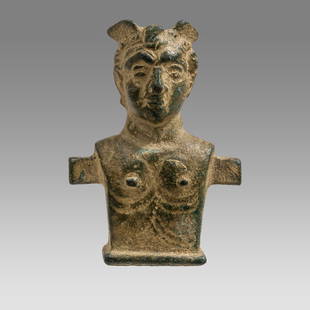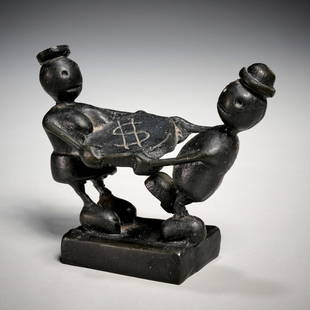
Roman Bronze Wagon Fitting w/ Bust of Herakles & Swans
Similar Sale History
View More Items in Sculptures & CarvingsRelated Sculptures & Carvings
More Items in Sculptures & Carvings
View MoreRecommended Art
View More










Item Details
Description
Rome, Imperial Period, ca. 2nd to 3rd century CE. Cast via the lost wax process, a bronze wagon/chariot fitting depicting a bust of Herakles (Hercules) wearing a lion skin and lion-headed cloak with fangs near his temples and paws tied around his neck, referencing Herakles' first labor in which King Eurystheus asked him to bring back the skin of a lion that terrorized the hills of Nemea. Discovering that his arrows were ineffective against the wild beast, Heracles eventually emerged victorious by using his brute strength and choking the lion to death. Flanking Herakles are two swans, adding more symbolism stemming from Greek mythology. Truly, an exceptional example with great attention to detail, in excellent condition, and boasting gorgeous green patina! Size: 8" W x 6.125" H (20.3 cm x 15.6 cm)
In the classical world, lions symbolized power, wealth, and might. They were famously featured in many ancient myths, perhaps the most famous being that of Heracles slaying the Nemean lion for his first labor. The lion's fur was believed to be impenetrable to attacks since, according to legend, it was made of gold and its claws were far sharper than swords with the power to slice through armor. In the end, Heracles defeated the lion by strangling it and wore its skin.
The ancient Greeks featured the story of Herakles and the Nemean lion on several beautiful vases. For example, a dramatic pottery painting of Hercules actually wrestling the Nemean lion is featured on an Attic black figure neck amphora, ca. 510-500 BCE at University Museums, University of Mississippi. Another Attic piece, a bilingual amphora in the collection of the Museum of Fine Arts, Boston, depicts Hercules wearing the lion skin (99.538) as described by Euripedes, "First he cleared the grove of Zeus of a lion, and put its skin upon his back, hiding his yellow hair in its fearful tawny gaping jaws." (Euripedes, Hercules, 359).
The swan played a complex role in Greek mythology - most often understood as the attribute of Aphrodite and Apollo, said to sing a song of unearthly beauty as it dies, and as the form assumed by Zeus to ravish Leda, mother of Helen of Troy. The latter, based on the writings of Ovid and Fulgentius, was well known in the European Middle Ages, and inspired artists, including Michelangelo, during the Italian Renaissance. However, the ancient Roman artisan who made this piece was probably depicting the swan as a general symbol of passion and beauty rather than a direct reference to the Zeus and Leda story.
However, given the juxtaposition of Herakles and the swans, it is also possible that the swans in this example refer to characters known as Cycnus or Cygnus whose name literally means "swan," most of whom were transformed into swans. Cycnus, the son of Ares and Pelopia (Pyrene), was a violent and evil man who lived in either Pagasae, Thessaly, or near the river Echedorus in Macedonia. He legendarily killed each and every one of his guests, that is, until Herakles ended his life. In the poem entitled, "Shield of Heracles," on the way to Trachis, Herakles and Iolaus encountered Cycnus and Ares; each pair was riding a chariot. Heracles was directing to the court of King Ceyx, whose daughter, Themistonoe, was married to Cycnus. Apollo, whose Pagasaean sanctuary was nearby the location where the characters meet, purportedly ignited Herakles' angst against Cycnus. Then Athena appeared and told Heracles that Zeus too had empowered him to defeat Cycnus. To ensure this, he instructed Herakles not to touch Cycnus' body or take his armor as spoils. Instead, he told Hercules to hit Ares with a spear in an unprotected area of body if he should attack Heracles to avenge ?ycnus's death. What ensued next? Heracles and ?ycnus engaged in a single combat, and Heracles used his spear to hit ?ycnus in the neck, killing him instantly. Then Ares was about to strike Heracles when Athena came to his aid and blocked his hit, announcing that he should not kill the hero. Heracles took advantage of this opportunity, wounded Ares in the thigh and beat him to the ground. This caused his sons Deimos and Phobos to rescue him and bring him back to Mount Olympus.
Cf. Mann und Ross und Wagen, exhibition catalogue, Munich, 1986, 59 ff.
Provenance: private collection; Luxembourg, acquired before 1980
All items legal to buy/sell under U.S. Statute covering cultural patrimony Code 2600, CHAPTER 14, and are guaranteed to be as described or your money back.
A Certificate of Authenticity will accompany all winning bids.
We ship worldwide to most countries and handle all shipping in-house for your convenience.
#123484
In the classical world, lions symbolized power, wealth, and might. They were famously featured in many ancient myths, perhaps the most famous being that of Heracles slaying the Nemean lion for his first labor. The lion's fur was believed to be impenetrable to attacks since, according to legend, it was made of gold and its claws were far sharper than swords with the power to slice through armor. In the end, Heracles defeated the lion by strangling it and wore its skin.
The ancient Greeks featured the story of Herakles and the Nemean lion on several beautiful vases. For example, a dramatic pottery painting of Hercules actually wrestling the Nemean lion is featured on an Attic black figure neck amphora, ca. 510-500 BCE at University Museums, University of Mississippi. Another Attic piece, a bilingual amphora in the collection of the Museum of Fine Arts, Boston, depicts Hercules wearing the lion skin (99.538) as described by Euripedes, "First he cleared the grove of Zeus of a lion, and put its skin upon his back, hiding his yellow hair in its fearful tawny gaping jaws." (Euripedes, Hercules, 359).
The swan played a complex role in Greek mythology - most often understood as the attribute of Aphrodite and Apollo, said to sing a song of unearthly beauty as it dies, and as the form assumed by Zeus to ravish Leda, mother of Helen of Troy. The latter, based on the writings of Ovid and Fulgentius, was well known in the European Middle Ages, and inspired artists, including Michelangelo, during the Italian Renaissance. However, the ancient Roman artisan who made this piece was probably depicting the swan as a general symbol of passion and beauty rather than a direct reference to the Zeus and Leda story.
However, given the juxtaposition of Herakles and the swans, it is also possible that the swans in this example refer to characters known as Cycnus or Cygnus whose name literally means "swan," most of whom were transformed into swans. Cycnus, the son of Ares and Pelopia (Pyrene), was a violent and evil man who lived in either Pagasae, Thessaly, or near the river Echedorus in Macedonia. He legendarily killed each and every one of his guests, that is, until Herakles ended his life. In the poem entitled, "Shield of Heracles," on the way to Trachis, Herakles and Iolaus encountered Cycnus and Ares; each pair was riding a chariot. Heracles was directing to the court of King Ceyx, whose daughter, Themistonoe, was married to Cycnus. Apollo, whose Pagasaean sanctuary was nearby the location where the characters meet, purportedly ignited Herakles' angst against Cycnus. Then Athena appeared and told Heracles that Zeus too had empowered him to defeat Cycnus. To ensure this, he instructed Herakles not to touch Cycnus' body or take his armor as spoils. Instead, he told Hercules to hit Ares with a spear in an unprotected area of body if he should attack Heracles to avenge ?ycnus's death. What ensued next? Heracles and ?ycnus engaged in a single combat, and Heracles used his spear to hit ?ycnus in the neck, killing him instantly. Then Ares was about to strike Heracles when Athena came to his aid and blocked his hit, announcing that he should not kill the hero. Heracles took advantage of this opportunity, wounded Ares in the thigh and beat him to the ground. This caused his sons Deimos and Phobos to rescue him and bring him back to Mount Olympus.
Cf. Mann und Ross und Wagen, exhibition catalogue, Munich, 1986, 59 ff.
Provenance: private collection; Luxembourg, acquired before 1980
All items legal to buy/sell under U.S. Statute covering cultural patrimony Code 2600, CHAPTER 14, and are guaranteed to be as described or your money back.
A Certificate of Authenticity will accompany all winning bids.
We ship worldwide to most countries and handle all shipping in-house for your convenience.
#123484
Condition
Minor chips to base, otherwise excellent.
Buyer's Premium
- 24.5%
Roman Bronze Wagon Fitting w/ Bust of Herakles & Swans
Estimate $12,000 - $18,000
2 bidders are watching this item.
Shipping & Pickup Options
Item located in Louisville, CO, usSee Policy for Shipping
Payment

TOP
















































































